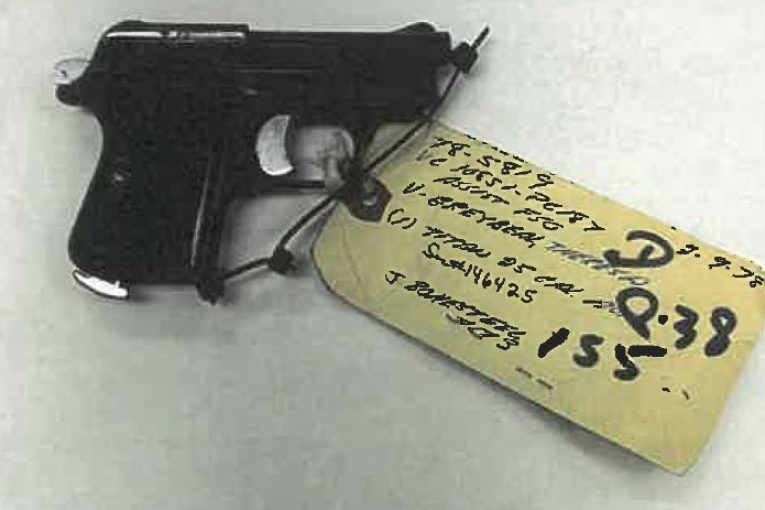

By David M. Greenwald
Executive Editor
Fresno, CA – The attorneys seeking to get Douglas “Chief” Stankewitz a new trial and hopefully released after being in prison since 1978 now have a big new piece of evidence to point to—the weapon that has been in custody, tests show, was not the murder weapon.
According a motion filed by the defense, “the new facts and evidence show that the gun introduced against Petitioner at trial was planted several days after police reported recovering it in Ms. Graybeal’s vehicle.”
They are now requesting a hearing before Judge Arlan Harrell in Fresno.
“This is the first time we have forensic confirmation of the 1973 date and what we believe is an officer’s ID number,” attorney Curtis Briggs told the Vanguard.
At the last hearing, February 3, 2023, the Prosecutor, Deputy DA Kelsey Peterson, had requested to allow the Fresno Crime Lab to do the testing for the weapon—which Briggs said was fine with them, “because we didn’t think that the Fresno Crime Lab was going to come up with a different result than our crime lab. So why not just have them render the results we were looking for?”
the results we were looking for?”
However, after all of that, “the crime lab refuses to test that weapon.”
Briggs explained, “People in law enforcement have told us there’s rumors about that gun in Fresno.” They have been told, “There’s an abnormality with that gun. It’s well known. So it was kind of funny to us when the Fresno Crime Lab wouldn’t test it.”
The newly discovered evidence from the forensic analysis of the holster, “confirms the defense allegation that the firearm in evidence is not the murder weapon.”
The FCL report states, “The scratches were deliberate and appeared to be markings to denote when the holster was recovered.”
The firearm in evidence was reported stolen in June 1973. “Approximately six weeks later, the holster was engraved by law enforcement with the date of 7-25-73. This establishes that law enforcement had the firearm from that date forward as there is no CLETS report or any other information showing the firearm was released to anyone.”
The CLETS (California Law Enforcement Telecommunications System), report according to the report and filing, “also contains a reference to Sacramento PD Internal Affairs Division. This indicates that Internal Affairs investigated the firearm.”
The filing continues, “This is a further indication that law enforcement had possession of the firearm because there appears to have been further investigation by Internal Affairs with respect to the firearm.”
“There are no further entries on either the CLETS report, the holster or the firearm until 2-10-78.”
That is when Graybeal was murdered. But the police were not able to locate a weapon on or near Stankewitz.
In 1978, Stankewitz and four others; Marlin Lewis, Christina Menchaca, Teena Topping, and Billy Brown became stranded in Modesto, CA, on their way back to Fresno.
They allegedly stole a young woman named Theresa Graybeal’s car and kidnapped her. Tragically, the plan spiraled out of control and one of them shot Graybeal in the head.
While in or near Graybeal’s vehicle, Stankewitz, Menchaca, Topping, and Lewis were arrested by Fresno police. Stankewitz was then accused of kidnapping, robbing, and then murdering Theresa Graybeal.
From the start he has maintained his innocence and that he was framed for this murder.
“Chief,” now in his 60s, would later be sentenced to death in multiple trials and is believed to be at one time the longest-serving inmate on San Quentin Prison’s Death Row.
He was resentenced to life without parole in 2019.
The filing argues, “Between 2/8/78 and 2/10/78, officers place the planted weapon in the car and take photographs as if they discovered the gun and holster for the first time.”
Moreover, “Detective Lean takes possession of the gun on 2/10/78 and begins processing it as though it is legitimate evidence. Detective Lean is not aware that the serial number should have been removed, nor does he look closely to identify that the holster has evidence processing indicators from 1973.”
Briggs told the Vanguard he believes “these should be pretty devastating to the prosecution’s case.”
He noted that Judge Harrell did not rule on the petitioners’ motion for OR or conditional examination. He took both matters under submission.
“The judge is really interested in what these firearm results were going to be,” Briggs said.
Briggs believes that the judge could signal the importance of this new evidence if he grants the motion for OR.
However, at this point, it might still take 3 to 6 months before there is another hearing, “because the DA still has to file a response and we get to attack that response.”
He said, “We might see some clues or some hints by the way the judge handles the motions that are pending because we’d filed a couple of very unusual motions.”

